JAPANESE AMERICAN 442nd RCT AT THRESHOLD OF FAME
Marseille, France • September 29, 1944
On this date in September 1944 three U.S. Liberty cargo ships arrived off the port of Marseille, France carrying the 442nd Regimental Combat Team (RCT), their weapons, and vehicles. The 442nd consisted of Nisei (second-generation Japanese American) volunteers from the U.S. West Coast and Hawaii who had been recruited, in the case of mainland Nisei, in U.S. concentration camps (euphemistically called “relocation camps”) where they, their siblings, and their Issei (first-generation Japanese) parents had been forcefully incarcerated in the months following the outbreak of war with Japan.
The 442nd was organized on March 23, 1943, in response to the U.S. War Department’s call for volunteers to form a segregated Japanese American army combat unit. The unit grew to its fighting complement of 4,000 men by the end of that month. The 442nd would eventually include its “big brother,” the 100th Infantry Battalion, whose servicemembers had enlisted in the U.S. Army in Hawaii before the war, the 522nd Field Artillery Battalion, along with several smaller companies such as antitank and combat engineer companies. In time the 442nd, whose motto was “Go for Broke,” would number 18,000 Nisei servicemen and become the most decorated unit for its size and length of service in U.S. military history (see photo essay).
The 100th Infantry Battalion first saw combat in Italy in September 1943 and the 442nd RCT and component units in June the next year, also in Italy. The June-amalgamated 100th/442nd was attached to Gen. Mark Clark’s Fifth Army and saw fierce fighting in Tuscany that summer as German and Italian fascist forces were relentlessly pushed up the Italian peninsula. The 442nd’s outstanding combat reputation reached the ears of the Supreme Allied Commander in Europe. Gen. Dwight D. Eisenhower separated the Nisei warriors from the Fifth Army and attached them to the Seventh Army for Gen. Alexander Patch’s drive north up France’s Rhône Valley toward the dark, piney, low-mountain range of the Vosges opposite the German border.
After trekking and hitching rides in boxcars for 400 miles/644 km, the 442nd reached the Vosges Mountains, now shrouded in October’s brooding cloud cover and cold, drizzling, often unremitting rain. On October 14 the Vosges campaign began. Seared into U.S. Army and Japanese American history is the 442nd’s storied rescue of the “Lost Battalion,” mostly Texas National Guardsmen of the 1st Battalion, 141st Infantry Regiment, 36th Infantry Division who 10 days later ended up trapped a mile/1.66 km or so behind German lines south of St‑Die. Spurning warnings of heavy enemy concentrations in unreconnoitered terrain ahead, 36th Infantry Division commander Maj. Gen. John Dahlquist ordered the newcomers to engage the foe shortly after the Texans’ arrival as the 442nd’s relief force. The Germans for their part sprung a trap to catch the unwitting newbies. Airdropped supplies of food, water, medicine, and weapons to the 275 ensnared GIs mostly wound up in enemy hands. Several attempts by other elements of the 141st to extricate their compatriots failed, after which a desperate Dahlquist recalled the 442nd, weary and battle-scared, not 2 days off-line, to relieve their relievers.
On the night of October 26/27, 1944, 442nd infantry began ascending the mountain to rescue the cut-off men. A short while later Dahlquist threw the rest of the RCT at the enemy: field artillerymen, antitank personnel, and combat engineers. Rainfall, snow, cold, mud, trench foot, bullets, and lethal shards of hot steel and exploding pine trees from tank-fired 88 mm shells bedeviled the Nisei rescuers. For 5 days their ascent was torturous. Fed up with the relentless crawling and crouching through dense stands of pine, leading 3rd Battalion Companies K and I rose up, ran full tilt toward the enemy, yelling, and shooting blind. Though they tried, the Germans failed to stop the fanatic “banzai” assault. Enemy ranks broke, Germans everywhere hightailing it behind a white smokescreen. On the afternoon of October 30 the 442nd rescued 211 survivors of the “Lost Battalion” at a cost of 800 of their own.
442nd Regimental Combat Team Aids Allies in Expelling Enemy from France
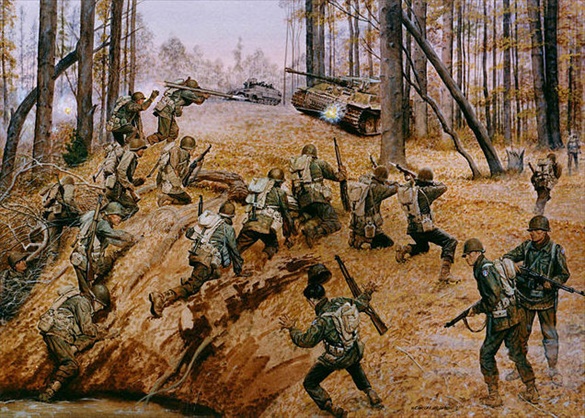 |
Above: “Go for Broke!,” H. Charles McBarron’s painting in the collection of the Army Center of Military History, Fort McNair, Washington, D.C., depicts the 442nd Regimental Combat Team assaulting German siege forces in their rescue of the so-called “Lost Battalion,” soon to be called the Alamo Regiment. On the night of October 26/27, 1944, the 442nd RCT, a second-generation Japanese American (Nisei) unit drawn from Hawaii and the U.S. West Coast and assigned to the 36th Infantry Division in Gen. Alexander Patch’s U.S. Seventh Army, was called on to rescue a surrounded U.S. battalion, mostly Texas National Guardsmen of the 141st Infantry Regiment who were trapped in the Vosges Mountains of Eastern France. The Texans had attacked the heavily fortified defenses of a superior German force comprising two grenadier regiments and a mountain battalion. Fighting was desperate, often hand-to-hand. Nearly half the Texans became casualties. Then on the fifth day into the rescue attempt came a disbelieving moment. By ones and twos and then en masse the men of the 442nd struggled to their feet on steep muddy mountain slopes and, facing murderous fire, charged the enemy’s positions, yelling “Make! Make! Make!”—“death” in Hawaiian. Bitter hand-to-hand combat ensued as the Nisei warriors swept from one fortified enemy position to the next. The Germans broke in disorder, returning and failing a final time to eradicate the Texans. On October 30, 1944, they abandoned the battlefield.
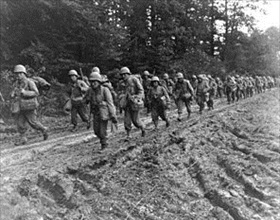 | 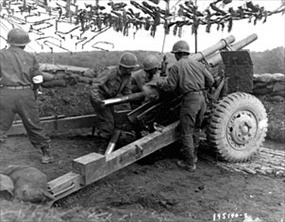 |
Left: On their way to liberate Bruyères, France, from German occupation, riflemen of the 2nd Battalion, 442nd Regimental Combat Team slog their way along a muddy logging road in the Chambois sector of the Vosges Mountains, October 14, 1944. Five months earlier, on May 1, 1944, the newly formed Nisei 442nd RCT left the States, landing at Anzio on the west coast of Italy 28 days later. In August the unit took part in Operation Dragoon, the Anglo-American and French invasion of Southern France, and then traveled up the Rhône Valley from Marseille by walking and by rail until October 13, when it reached the edges of Vosges Mountains. On October 23 the unit, whose motto was “Go for Broke” (craps game lingo for “shoot the works”), was ordered to rescue the so-called “lost battalion” of 141st Infantry Regiment (Alamo Regiment) of the 36th Infantry Division. It cost the 442nd 800 casualties to rescue 211 men.
![]()
Right: The 522nd Field Artillery Battalion fires 105mm shells in support of an infantry attack by the 442nd Regimental Combat Team in the Vosges Mountains of Northeastern France near the village of Bruyères, a transportation and communications hub. The 442nd was the most decorated unit for its size and length of service in the history of American warfare. Almost as self-sufficient as a division, the men of the 442nd RTC included the 522nd Field Artillery Battalion, the 100th Infantry Battalion, combat-engineer, antitank, cannon, and service companies. They accounted for just over 40 percent of the Japanese Americans who served in the U.S. military in World War II. In less than 2 years its members—in total, about 18,000 men who ultimately served in the 442nd—earned 29 Distinguished Service Crosses, 560 Silver Stars, 28 Silver Stars with oak leaf clusters (in place of a second Silver Star), 22 Legion of Merit Medals, 4,000 Bronze Stars, 1,200 Bronze Stars with oak leaf clusters, 36 Army Commendation Medals, 87 Division Commendations, 21 Congressional Medals of Honor (including one awarded to future U.S. senator Daniel Inouye [1924–2012] of Hawaii), and more than 4,000 Purple Hearts (the 442nd is also known as the Purple Heart Battalion). The unit was awarded an unprecedented 8 Presidential Unit Citations. In 1968 Gov. John Connally made the entire 442nd RCT honorary Texans. In 2012 France made all surviving members of the 442nd chevaliers (knights) of the French Légion d’Honneur, the highest French order of merit for military and civil distinction, for their actions contributing to the liberation of France and their heroic rescue of the Lost Battalion.
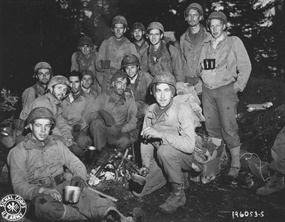 | 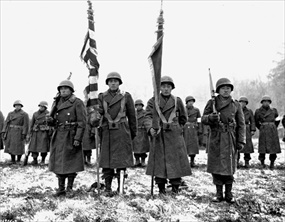 |
Left: Members of 1st Battalion, 141st Infantry, 36th Infantry Division warm themselves around a fire after their rescue while waiting for transportation to the rear, October 31, 1944. Before they became known as the Lost Battalion, the 1st Battalion was a part of the 36th Infantry Division fighting in Europe during World War II. After a bungled strategic decision sent them deep into German territory in Northeastern France, the battalion was surrounded. For 6 days, the 275 soldiers remained trapped with dwindling airdropped supplies as the Germans threatened to wipe them out and repelled repeated rescue attempts on the ground. Adolf Hitler is said to have taken a personal interest in seeing the American battalion completely destroyed. In a last-ditch effort, the 442nd Regimental Combat Team was sent in to break through the staunch German defenses. They paid a steep price to come out the other side.
![]()
Right: Color guard of the Japanese American 442nd Regimental Combat Team stand at attention in a snowy grass field under a leaden sky near Bruyères, France, November 12, 1944, while team citations for bravery were read aloud. “Go for Broke” was more than a motto for the Nisei servicemen. At the November 12 ceremony, the utterly clueless 36th Infantry Division commander Maj. Gen. John Dahlquist, scowled at the paltry number of men standing in heavy, oversized winter coats in ranks before him. He turned to the officer next to him, hissing loudly why the whole regiment was not present for his review. Stunned, Lt. Col. Virgil Miller, who had recently assumed command of the 442nd and had been with the One-Puka-Puka, its “big brother,” the 100th Infantry Battalion, since its beginnings in 1941, responded in a wavering voice after a long, awkward silence, “General, this is the regiment. This is all I have left.”
The 442nd Regimental Combat Team and the Rescue of “The Lost Battalion”
![]()

 History buffs, there is good news! The Daily Chronicles of World War II is now available as an ebook for $4.99 on Amazon.com. Containing a year’s worth of dated entries from this website, the ebook brings the story of this tumultuous era to life in a compelling, authoritative, and succinct manner. Featuring inventive navigation aids, the ebook enables readers to instantly move forward or backward by month and date to different dated entries. Simple and elegant! Click
History buffs, there is good news! The Daily Chronicles of World War II is now available as an ebook for $4.99 on Amazon.com. Containing a year’s worth of dated entries from this website, the ebook brings the story of this tumultuous era to life in a compelling, authoritative, and succinct manner. Featuring inventive navigation aids, the ebook enables readers to instantly move forward or backward by month and date to different dated entries. Simple and elegant! Click 











